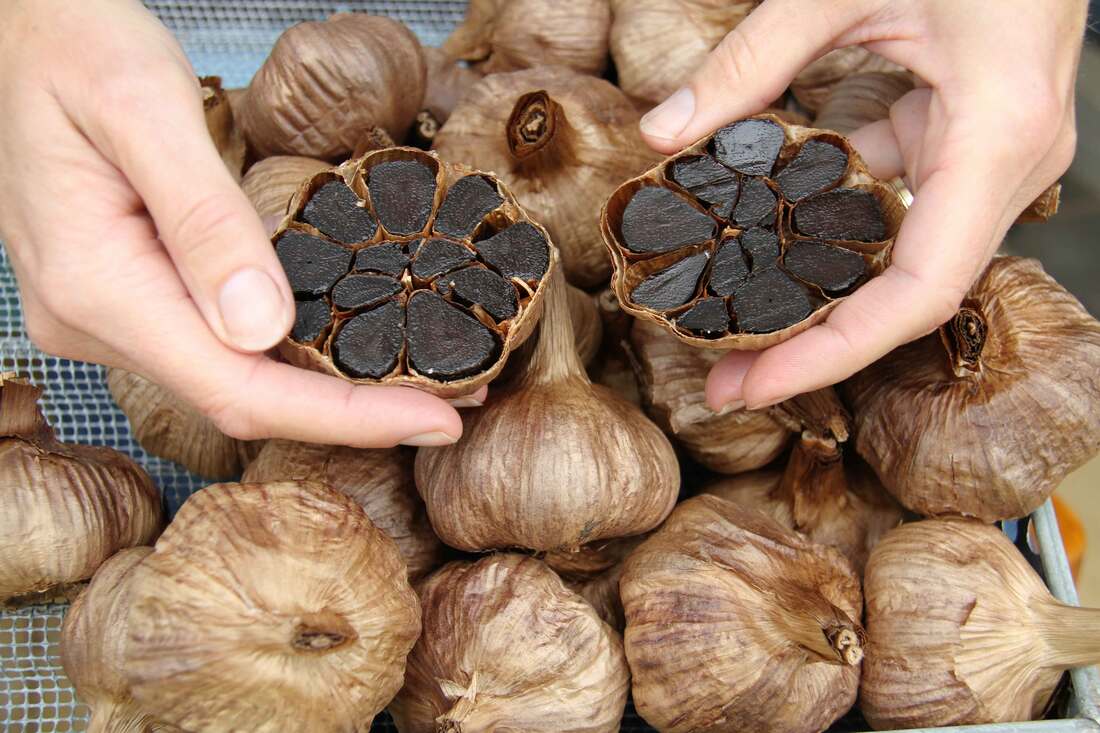Have you ever found yourself savoring the sweet, umami-laden taste of black garlic—only to pause and wonder if there’s a chance it could trigger an allergic reaction you’ve never experienced with raw garlic? While black garlic stems from the same bulb we use in everyday cooking, its fermentation process does alter its composition. Let’s take a closer look at how (and if) these changes could affect those who typically have no issues with raw garlic.
Black Garlic vs. Raw Garlic
-
Fermentation Process: Black garlic is made by aging whole bulbs of raw garlic in a warm, humid environment over several weeks. The result is a transformation in both flavor and chemical composition.
-
Flavor & Texture: Raw garlic is famously pungent, with a sulfuric bite. Black garlic, on the other hand, is sweet and almost caramel-like, lacking the sharpness of its raw counterpart.
-
Chemical Changes: The long fermentation reduces certain compounds (such as allicin) and increases others (including antioxidants and some amino acids). This may affect how the body responds if an individual is prone to allergies or sensitivities.
Garlic Allergies Explained
-
True Garlic Allergy: Some people are allergic to proteins in garlic bulbs themselves. Common symptoms include skin irritation, digestive issues, or, in severe cases, respiratory problems. If you’ve cooked with or eaten raw garlic your entire life without adverse effects, you’re likely not allergic to those particular proteins.
-
Cross-Reactivity: Garlic belongs to the Allium family, which includes onions, leeks, chives, and shallots. Sometimes an allergy to one Allium can mean an allergy to another—though this is not always the case.
-
Histamine or Other Sensitivities: Occasionally, issues arise not from a garlic-specific allergy but from an intolerance to chemicals like histamine, which can increase during fermentation.
Fermentation & Allergies: A Potential Twist
While fermentation generally breaks down some of the proteins that can cause allergic reactions, it can also create new compounds. For example:
-
Increased Histamine: Many fermented foods (like cheese, wine, or certain fermented vegetables) can have higher levels of histamine. For those sensitive to histamine, black garlic may pose a challenge.
-
Modified Proteins: The proteins in garlic that trigger allergies might be altered or diminished during fermentation—potentially reducing or eliminating allergic responses for some individuals. Conversely, new or modified compounds could cause unexpected sensitivities in rare cases.
It’s relatively uncommon for someone to have no reaction to raw garlic yet develop an allergy or intolerance specifically to black garlic. However, the possibility exists, especially for those with a history of food intolerances or sensitivities to fermented products.
Signs You May Be Allergic or Intolerant to Black Garlic
If you’re concerned about whether you could be allergic or sensitive to black garlic, watch out for the following symptoms after consuming it:
-
Gastrointestinal Discomfort: Bloating, stomach pain, or diarrhea could indicate an issue.
-
Skin Reactions: Hives, itching, or redness around the mouth can be telltale signs of an allergy.
-
Respiratory Symptoms: Sneezing, runny nose, or breathing difficulties are more severe indications that you should discontinue use and consult a medical professional immediately.
-
Flushing or Migraines: These can be associated with histamine intolerance and may appear when consuming fermented foods.
What to Do If You Suspect an Allergy
-
Elimination Test: Remove black garlic from your diet and see if symptoms resolve. Then, reintroduce it in small amounts to see if the symptoms recur.
-
Consult a Professional: Reach out to an allergist or healthcare provider for testing or a more personalized assessment—especially if symptoms are severe.
-
Read Labels Carefully: If you buy processed foods containing black garlic (e.g., sauces, condiments, or snacks), ensure you know what’s in them, and watch out for other potentially allergenic ingredients.
Tips for Enjoying Black Garlic Safely
-
Start Small: If you’re curious about black garlic but feeling cautious, try a tiny taste first. Note any reactions before indulging further.
-
DIY Fermentation: Making black garlic at home (in a dedicated fermentation device or rice cooker) can give you control over ingredients and fermentation time. If you have known intolerances, you can adjust the process accordingly (though homemade fermentation always carries some risk of contamination if not done properly).
-
Seek Alternatives: If black garlic causes discomfort, consider using roasted garlic in recipes. It’s less pungent than raw garlic and still offers a sweet depth of flavor—without the fermentation process that might spark an unwanted reaction.
Final Thoughts
While it’s possible—though relatively rare—to develop an allergy or intolerance to black garlic specifically, most people who handle raw garlic with ease don’t experience issues. If you’re excited to explore the sweet-and-savory world of black garlic, begin with a moderate approach and pay close attention to your body’s cues. When in doubt, consult a healthcare professional to ensure you can enjoy this gourmet ingredient with confidence and peace of mind.
Have you experienced any unusual reactions to black garlic? Share your thoughts or questions in the comments. Let’s keep the conversation open so everyone can make informed, delicious decisions in the kitchen!

Comments (0)
No comments yet. Be the first to comment!